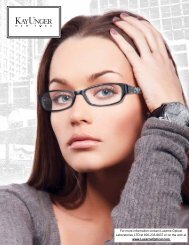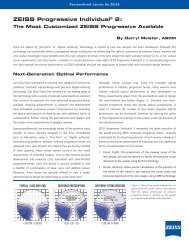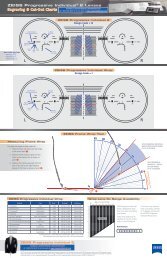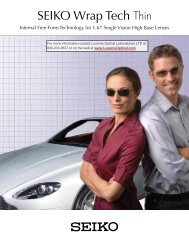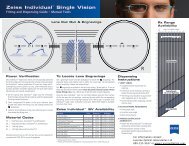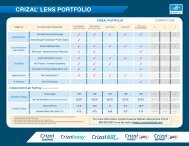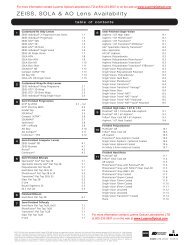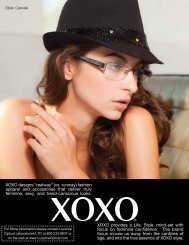LAB INNOVATOR OF 2010 - Luzerne Optical Labs
LAB INNOVATOR OF 2010 - Luzerne Optical Labs
LAB INNOVATOR OF 2010 - Luzerne Optical Labs
Create successful ePaper yourself
Turn your PDF publications into a flip-book with our unique Google optimized e-Paper software.
<strong>LAB</strong> <strong>INNOVATOR</strong> <strong>OF</strong> <strong>2010</strong>Q&A WITH NEIL DOUGHERTYBuilt on an Independent FoundationNow run with the help of the second generation of the Dougherty family, <strong>Luzerne</strong> <strong>Optical</strong> of Wilkes-Barre, PA,continues its tradition of growth as an independent wholesale optical lab.JIM GROOTEGOED: Please tell usabout the history of <strong>Luzerne</strong> <strong>Optical</strong>.NEIL DOUGHERTY: The company wasstarted in 1973 by my mother and father.When my father got out of high school, hewent into the military. His first job out waswith Balester <strong>Optical</strong> in Wilkes-Barre. Hebecame their production manager. He wasthere for 13 years when a large corporationstarted buying independently owned laboratoriesacross the country, and Balesterwas one of those. He saw what was goingon and said, “This is a good time to get outand start my own business.”He felt there was a need for a locallyowned independent wholesale lab thatcould provide personalized service for itscustomers. Most people thought he wascrazy. They said, “You have this great job,five children, why would you want to leavethis position?” But my mother encouragedand supported him, so they started <strong>Luzerne</strong><strong>Optical</strong> in 1973.The name came from the countywe’re in, <strong>Luzerne</strong> County, named afterthe French nobleman and minister tothe U.S., Chevalier de la <strong>Luzerne</strong>, whowas sent to help the American Revolution.Plastic hadn’t arrived yet, so it was glasslenses and frames. The business grewsteadily over the years. We outgrew ourfirst building and in 1984 built a new,20,000-sq.-ft., state-of-the-art facility inthe downtown Wilkes-Barre IndustrialPark. In 1985, we added gas permeablecontact lens manufacturing on site, and in1994, we were the first lab in Pennsylvaniato manufacture anti-reflective (AR) in-house.In 2002, we were so tight we knockedout the walls to our garage and expandedour surfacing room. We also automatedour inventory room, installing Lektrieversystems interfaced with our DVI LMSsoftware. In 2002 we also added the CrizalAR facility, which was the first non-Essilorownedlab installation along with Walman<strong>Optical</strong>.Then, in 2009 we began processingfree-form lenses in house. With the firstSchneider generator distributed at thattime by Zeiss, we probably had free-formequipment before anybody in the U.S.Now we’re on our fourth generation ofSchneider equipment. We were waitingfor the free-form manufacturing processto come along. The software wasn’t ready.The equipment manufacturers weren’tready. So even though we had the technologysitting there years earlier, wecouldn’t implement it until all of thosepieces fell into place around 2009.JG: Why did you choose Schneider?ND: Gunter was so committed to hismachinery, plus they were the first withproven and productive machinery in thefree-form category worldwide before itcame to the U.S.JG: I noticed your product list is verycomprehensive in terms of the manufacturersyou support.ND: We have a vast array of products, justabout every lens line or treatment.That’s one of the things that gives<strong>Luzerne</strong> a competitive advantage.JG: That’s a challenge with new technologies—ARand now free-form.ND: We’re well positioned in AR and freeform.We have two different AR labs withfour AR systems. If one goes down, wehave backup and support. We were one ofthe first with the Zeiss process in 199420 november/december <strong>2010</strong>




